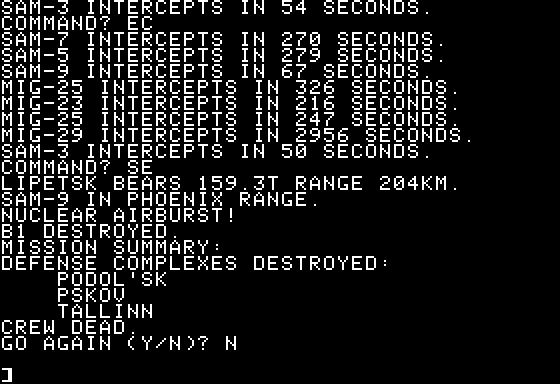| B-1 Nuclear Bomber | |
|---|---|
| Developer(s) | Microcomputer Games |
| Publisher(s) | Avalon Hill |
| Platform(s) | Apple II, Atari 8-bit, PET, VIC-20, Commodore 64, MS-DOS, TRS-80, CP/M, TI-99/4A |
| Release | 1981: Atari |
| Genre(s) | Flight simulator |
| Mode(s) | Single-player |
B-1 Nuclear Bomber is a flight simulator developed by Avalon Hill and Microcomputer Games and released in 1980 for the Apple II and other computers.[2][3] The game is based on piloting a B-1 Lancer to its target and dropping a nuclear bomb.[4] The USSR is one of the target countries.
Gameplay[edit]
Strategic bomber. Quite the same Wikipedia. In three major military operations, the US used B-1 bombers in missions aimed at Chinese fortified reefs and islands in the South China Sea, a strategic.
The game box details a sample scenario set in the then-future of a bombing run over Moscow on July 1, 1991, which turned out to be just months before the official dissolution of the Soviet Union on December 26 of that year.
Reception[edit]
Larry Kerns reviewed B-1 Nuclear Bomber in The Space Gamer No. 33. Kerns commented that 'Overall, I feel that the [...] price tag is too high and the game is quickly boring. The big fancy box is a waste and although putting all three languages on one tape is an innovative idea, two-thirds of what you bought is wasted. I expected more from Avalon Hill's baby but was disappointed. I hope their other new games are better.'[5]
Chris Cummings reviewed the game for Computer Gaming World, and stated that 'B-1 Nuclear Bomber [...] will bring hours of fun, especially to the war monger who has always wondered what it would be like to sit in the cockpit of a sophisticated flying machine and drop a nuclear load on the 'enemy'.'[6]
In March 1983 B-1 Nuclear Bomber tied for eighth place in Softline's Dog of the Year awards 'for badness in computer games', Atari 8-bit family division, based on reader submissions.[7] A 1992 Computer Gaming World survey of wargames with modern settings gave the game zero stars out of five, stating that 'its play mechanics were embarrassing when it was initially released'.[8] The magazine in 1994 said that AH's games such as B-1 'were dated even when they were released back on the old 8-bit machines'.[9]
References[edit]
B 1 Nuclear Bomber
- ^B-1 Nuclear Bomber Release Information for Commodore PET - GameFAQs
- ^B-1 Nuclear Bomber for Apple II (1980), Moby Games
- ^Loguidice, Bill (2012-07-28). 'More on Avalon Hill Computer Games on Heath/Zenith platforms'. Armchair Arcade. Retrieved 22 July 2015.
- ^Two Games Of Strategy, Dale F. Brown, COMPUTE! ISSUE 49 / JUNE 1984 / PAGE 72
- ^Kerns, Larry (November 1980). 'Capsule Reviews'. The Space Gamer. Steve Jackson Games (33): 36.
- ^Cummings, Chris (November–December 1981). 'B-1 Nuclear Bomber: A Strategic Map'. Computer Gaming World. 1 (1): 18–19.
- ^'Everybody Doesn't Like Something'. Softline. March 1983. pp. 22–23. Retrieved 28 July 2014.
- ^Brooks, M. Evan (June 1992). 'The Modern Games: 1950 - 2000'. Computer Gaming World. p. 120. Retrieved 24 November 2013.
- ^Coleman, Terry Lee (July 1994). 'He Ain't Heavy, He's My Sovereign'. Computer Gaming World. pp. 110–111.

B 1 Nuclear Bomber Game
External links[edit]

B-1 Nuclear Bomber Mac Os Catalina
- B-1 Nuclear Bomber at Atari Mania